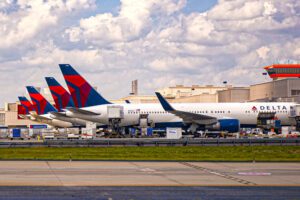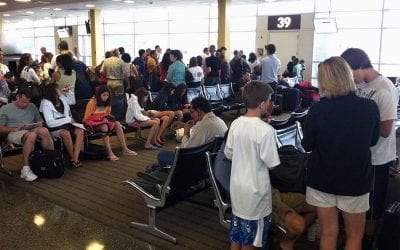Severe air turbulence causes severe injury to passengers. Follow my four easy-to-use rules that protect you during severe turmoil.
 Last week, Delta Air Lines Flight 175 traveled from Milan, Italy, to Atlanta, Georgia. The Airbus A350 was about 40 miles from Atlanta when severe air turbulence injured twelve on the flight, eight passengers and four crew members. According to the Federal Aviation Administration (FAA), one crew member was seriously injured.
Last week, Delta Air Lines Flight 175 traveled from Milan, Italy, to Atlanta, Georgia. The Airbus A350 was about 40 miles from Atlanta when severe air turbulence injured twelve on the flight, eight passengers and four crew members. According to the Federal Aviation Administration (FAA), one crew member was seriously injured.
I’ve written about severe air turbulence before. I still don’t understand why more air travelers don’t take the potential of severe air turbulence more seriously by taking easy-to-use, commonsense preventative measures.
Of the people injured on the flight by severe turbulence, two were injured seriously enough to be carried off the plane on stretchers
According to reports, it quickly dropped when severe air turbulence hit the Delta airplane. Ayo Suber, a passenger on the plane, posted a video, plus an account of the turbulence incident on Instagram. She said that passengers were flying out of their seats and that one woman hit the overhead bin and cracked it. In her video. We can see the cracked overhead bin that Ms. Suber mentioned. An ice pack was held on a woman’s head, a person being assisted while walking off the plane, bandaged and wearing a neck brace, plus two people being carried off the plane on stretchers.
By far, the most important action that passengers can take to prevent injury from severe turbulence is to fasten their seat belts snuggly whenever seated during flights. Likewise, parents flying with their children need to ensure that they’re also wearing their seat belts while seated.
Approximately 58 people each year in the US are injured by turbulence while not wearing their seat belts.
Some important statistics that air travelers need to know about air turbulence include:
- Each year, approximately 58 people in the United States are injured by turbulence while not wearing their seat belts.
- U.S. air carriers had more than 200 air turbulence accidents, resulting in 164 serious injuries,131 to the flight crew and 33 to passengers, from 2008 through 2022.
- Since 1980, there have been three fatalities sustained from severe turbulence, two documented to be passengers who weren’t wearing their seat belts while the seat belt sign in their planes was illuminated.
- More than one third of the air turbulence accidents occurred at or above 25,000 feet while the aircraft were cruising.
- Almost 60 percent of all air turbulence accidents occurred during the descent phase of flights.
While the number of flights encountering severe air turbulence is increasing in number.
 Compared to the number of flights and the number of people flying, the number of incidents and those injured seriously by severe air turbulence may seem tiny. Still, the increasing number of serious turbulence incidents is troubling, particularly in light of how easy it is for passengers to remain safe during accidents generally.
Compared to the number of flights and the number of people flying, the number of incidents and those injured seriously by severe air turbulence may seem tiny. Still, the increasing number of serious turbulence incidents is troubling, particularly in light of how easy it is for passengers to remain safe during accidents generally.
Clear-air turbulence is invisible. It’s undetectable by in-flight weather radar. At times, to an extent, it can be detected by a technology called LIDAR, using a combination of radar and lasers. Turbulence is difficult to forecast accurately.
Turbulence is generated by eddies in the atmosphere windshears, mainly concentrated in jet streams. According to a study by Dr. Paul Williams, professor of Atmospheric Science at the University of Reading, et al, the increase of wind shearing in jet streams is consistent with the expected effects of climate change and is expected to increase from 17 to 29 percent by the end of the century.
Turbulence strong enough to injure passengers and crew could double or triple in frequency.
Dr. Williams stated in an article in June that, “Turbulence strong enough to pose an injury risk could double or triple in frequency.”
A report was prepared in August 2021. In the Safety Research Report, “Preventing Turbulence-Related Injuries in Air Carrier Operations…,” the NTSB (National Transportation Safety Board) explained incidents from 2009 through 2018. Turbulence-related accidents accounted for more than a third of all accidents on regularly scheduled air carriers. Most of them result in one or more severe injuries.
There are actionable items that the airline industry can take to combat air turbulence accidents and injuries. The NTSB issued safety recommendations for “improving weather forecasting, dissemination of weather reports, and air traffic management practices.” The NTSB also issued recommended improvements in submitting and disseminating pilot weather reports, essential for airlines and pilots’ route planning for air traffic controllers to keep air traffic flowing safely, and for meteorologists to verify and amend aviation weather forecasts and advisories for safe flying.
In addition, the airlines need to improve their wind shear detection by working with industry and researchers on improving instruments such as LIDAR to detect wind shear conditions and install the devices in all their aircraft.
I’ve been on flights where passengers were injured by severe turbulence while not wearing seat belts.
I’ve been on several flights over the years that encountered severe turbulence. On one particular flight, had I not been wearing my seat belt snuggly, the severe turbulence would have forcefully thrown me against the plane’s ceiling, like the woman on the Delta flight described above. Three people on the flight sustained head injuries because they wouldn’t follow flight attendant instructions to wear and tighten their seat belts. I saw them bleeding from head wounds.
Had there been babies or toddlers held in their parents’ laps, I have no doubt that the children would have been severely injured and needing hospitalization. No parent can successfully hold onto a child during severe turbulence. Fortunately, there weren’t any children on the flight.
I have four commonsense rules to help keep yourself safe during severe turbulence.
There are four commonsense rules every air traveler should follow to prevent being injured from severe turbulence on their flights:
1. Fasten your seat belt:
The single most important action that you can take when flying is to fasten your seat belt snuggly, but not so tight that it’s uncomfortable, whenever you’re seated during your flight, whether or not the seat belt sign is on. Often, there’s no severe turbulence warning, so you must always be prepared for turbulence. Even when lying in a lie-flat seat, wear your seat belt snuggly enough to be safe.
2. Babies and young children:
Even though children under two can be legally held in a parent’s lap, don’t do it. All small children should be safely restrained in a standard seat/seat belt in an approved child safety seat. They should be strapped to their separate seats on the plane. Severe turbulence can exert as much force as 2½ Gs. No parent is capable of holding a child under that circumstance.
3. Stow your gear:
Secure your travel gear items to prevent them from becoming dangerous projectiles during severe air turbulence. Stow games, tablets, cameras, laptop computers, etc., in your carry-on or personal item.
4. Keep overhead bin doors closed:
After retrieving belongings from your carry-on in an overhead bin, immediately re-close the door and latch it. Even mild turbulence can cause gear in the overhead bins to fall out on passengers’ heads.
Severe turbulence is a real possibility on any flight. Don’t be your own worst enemy when you fly. Prepare for the worst while hoping for the best. Follow all my suggestions to stay safe during your flight. If you do nothing else, keep your seat belt snuggly fastened whenever you’re seated.
 (Image: Delta Airlines aircraft lined up at the gate. Copyright © 2023 NSL Photography. All Rights Reserved.)
(Image: Delta Airlines aircraft lined up at the gate. Copyright © 2023 NSL Photography. All Rights Reserved.)
READ ALSO:
Should checked baggage fees be refunded for delayed baggage?
AA’s record $4.1 million tarmac delay fine — not a penny goes to travelers
After many years working in corporate America as a chemical engineer, executive and eventually CFO of a multinational manufacturer, Ned founded a tech consulting company and later restarted NSL Photography, his photography business. Before entering the corporate world, Ned worked as a Public Health Engineer for the Philadelphia Department of Public Health. As a well known corporate, travel and wildlife photographer, Ned travels the world writing about travel and photography, as well as running photography workshops, seminars and photowalks. Visit Ned’s Photography Blog and Galleries.



